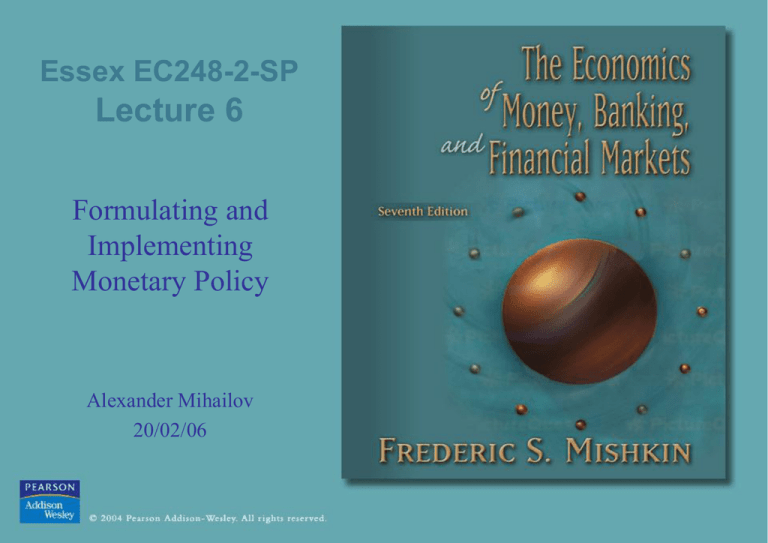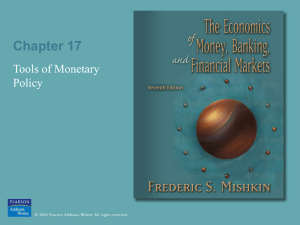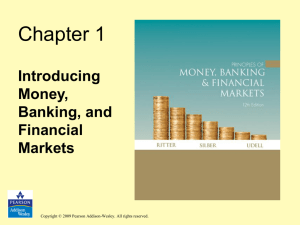
Essex EC248-2-SP
Lecture 6
Formulating and
Implementing
Monetary Policy
Alexander Mihailov
20/02/06
Plan of Talk
•
1.
2.
3.
4.
5.
6.
•
Introduction
The Market for Reserves and the Federal Funds Rate
Tools /Instruments/ of Monetary Policy
Goals of Monetary Policy
Targets of Monetary Policy
Alternative Monetary Strategies
The Transmission Mechanism of Monetary Policy
Wrap-up
© 2004 Pearson Addison-Wesley. All rights reserved
6-2
Aims and Learning Outcomes
• Aims
– Understand how central banks implement monetary policy
– Discuss the transmission mechanism of their actions
• Learning outcomes
– Distinguish the tools, instruments, targets and goals of
monetary policy
– Compare different views on the transmission mechanism
– Comment on the role and limitations of monetary policy
© 2004 Pearson Addison-Wesley. All rights reserved
6-3
The Market for (Bank) Reserves
and the (Equilibrium) Fed Funds Rate
Demand Curve for Reserves
1. R = RR + ER
2. i opportunity cost of ER => ER
3. Demand curve slopes down
Supply Curve for Reserves
1. If iff is below id, then discount borrowing, Rs = Rn
2. Supply curve flat (infinitely elastic) at id because as iff starts to go
above id, banks borrow more at id
Market Equilibrium
Rd = Rs at i*ff
© 2004 Pearson Addison-Wesley. All rights reserved
6-4
Supply and Demand for (Bank) Reserves
Supply Curve, Rs
Vertical section, Rn
Horizontal section, Rb
© 2004 Pearson Addison-Wesley. All rights reserved
6-5
iff Response to Open Market Operations
Open Market Purchase
Nonborrowed reserves,
Rn, supply curve
shifts right, to Rs2:
i1ff to i2ff
© 2004 Pearson Addison-Wesley. All rights reserved
6-6
iff Response to Change in the Discount Rate
(a) No discount lending
Lower Discount Rate
Horizontal section and vertical
section just shortens, iff stays same
(b) Some discount lending
Lower Discount Rate
Horizontal section , vertical
section shortens, iff to i2ff = i2d
6-7
iff Response to Change in Required Reserves
Required reserve
ratio
Demand for reserves ,
Rd shifts right and iff
to i2ff
© 2004 Pearson Addison-Wesley. All rights reserved
6-8
Open Market Operations (OMOs)
2 Types
1. Dynamic: meant to change MB
2. Defensive: meant to offset other factors affecting MB
Fed typically uses repos, which combine features of an OMO and a swap
and have only a temporary (1–15 days) effect on MB: 2 types
a) repurchase agreements repos
Fed purchases, seller agrees to repurchase
b) matched sale-purchase transaction reverse repos
Fed sells, buyer agrees to sell back
Advantages
1.
2.
3.
4.
Fed initiates OMOs and thus has complete control over their volume
Flexible and precise, no matter how small a change in R (=> MB) desired
Easily reversed, if iff considered too low or too high
Implemented quickly, no administrative delay involved
© 2004 Pearson Addison-Wesley. All rights reserved
6-9
Discount Loans/Policy
3 Types
1. Primary Credit: all healthy banks can borrow at id (usually, 1 pp = 100 bp > iff)
2. Secondary Credit: all banks in financial trouble can borrow at id + 0.5 pp = 50 bp:
not much used (costly), intended as a backup source of liquidity
3. Seasonal Credit: touristic or agriculural regions (to be discontinued)
Advantage: Lender of Last Resort Function
1. To prevent banking panics
FDIC fund not big enough (roughly, 1% of cover)
Example: Continental Illinois, 1984, $5+ bln
2. To prevent nonbank financial panics
Examples:
– October 19 (“Black Monday”), 1987 stock market crash: largest one-day decline in
stock prices (Dow Jones Industrial Average: more than 20%), Fed announcement
– September 11 (“Terrible Tuesday”), 2001 terrorist destruction of World Trade
Center: worst terrorist incident, $45 bln in discount loans and $80 bln in OMOs
Disadvantages
1. Confusion interpreting id changes (since February 1994, Fed targets iff; since
January 2003, Fed does not use the discount facility to set iff)
2. Fluctuations in discount loans cause unintended fluctuations in money supply
3. Not fully controlled by Fed (vs OMOs)
© 2004 Pearson Addison-Wesley. All rights reserved
6-10
Reserve Requirements
Changes in the required reserve ratio affect the money
multiplier, hence Ms
Advantage (?)
1. Powerful effect, equal across banks
Disadvantages
1. Small changes have very large effect on Ms
2. Raising causes liquidity problems for banks
3. Frequent changes cause uncertainty for banks
4. Act as tax on banks
– eliminated in Canada (1992-1994), Switzerland, New Zealand, Australia
– not much used elsewhere
– in US, eliminated on time deposits in 1990, reduced from 12% to 10% on
checkable deposits
© 2004 Pearson Addison-Wesley. All rights reserved
6-11
(Ultimate) Goals of Monetary Policy
1. Price Stability: primary (if not unique) goal for most
central banks today, e.g. ECB, SNB
1. Interest Rate / (Money) Market Stability
2. Foreign Exchange Rate / Market Stability
2. Financial Market Stability
3. Economic Growth (in US: Fed)
4. High Employment (in US: Fed)
Often in conflict (if many)!!!
© 2004 Pearson Addison-Wesley. All rights reserved
6-12
Central Bank Strategy
© 2004 Pearson Addison-Wesley. All rights reserved
6-13
Money Supply Target
1. M d fluctuates
b/n M d' and M d''
2. With M-target at M*,
i fluctuates b/n i' and i''
© 2004 Pearson Addison-Wesley. All rights reserved
6-14
Interest Rate Target
1. M d fluctuates
b/n M d' and M d''
2. To set i-target at i*,
Ms fluctuates b/n
M' and M''
© 2004 Pearson Addison-Wesley. All rights reserved
6-15
Criteria for Choosing Targets
Criteria for Intermediate Targets
1. Measurability
2. Controllability
3. Ability to predictably affect goals => transmission
mechanism of monetary policy (considered later)
Interest rates are not clearly better than Ms on criteria 1 and 2
because it is hard to measure and control real interest rates
Criteria for Operating Targets
Same criteria as above
Reserve aggregates and interest rates are about equal on
criteria 1 and 2. For 3, if intermediate target is Ms, then
reserve aggregate is better
© 2004 Pearson Addison-Wesley. All rights reserved
6-16
Role of a Nominal Anchor
Ties Down Expectations
Helps Avoid Time-Consistency Problem
1. Arises from pursuit of short-term goals which lead to bad
long-term outcomes
2. Time-consistency resides more in political process
3. Nominal anchor limits political pressure for timeconsistency
© 2004 Pearson Addison-Wesley. All rights reserved
6-17
Summary: Advantages and Disadvantages of
Different Monetary Policy Strategies
© 2004 Pearson Addison-Wesley. All rights reserved
6-18
Summary: Advantages and Disadvantages of
Different Monetary Policy Strategies
© 2004 Pearson Addison-Wesley. All rights reserved
6-19
Monetary Targeting
Canada
1. Targets M1 till 1982, then abandons it
2. 1988: declining targets, M2 as guide
United Kingdom
1. Targets M3 and later M0
2. Problems of M as monetary indicator
Japan
1. Forecasts M2 + CDs
2. Innovation and deregulation makes less useful as monetary indicator
3. High money growth 1987-1989: “bubble economy,” then tight money policy
Germany and Switzerland
1. Not monetarist rigid rule
2. Targets using M0 and M3: changes over time
3. Allows growth outside target for 2-3 years, but then reverses overshoots
4. Key elements: flexibility, transparency, and accountability
6-20
Inflation
Targeting in
New Zealand,
Canada, and
the UK
6-21
Monetary Policy
with an Implicit Nominal Anchor
Forward-Looking and Preemptive to Deal With
Long Lags
Advantages
1. Focus on domestic considerations
2. Has worked very well in the U.S.
3. If It Ain’t Broke Why Fix It?
Disadvantages
1. Lack of transparency and accountability
2. Dependence on personalities
3. Inconsistent with democratic principles
© 2004 Pearson Addison-Wesley. All rights reserved
6-22
Taylor Rule, NAIRU and the Phillips Curve
Taylor (1993) Rule
(nominal) Fed funds rate target = inflation rate +
“equilibrium” real fed funds rate +
1/2 (inflation gap) +
1/2 (output gap)
Phillips Curve Theory
One rationale for having the output gap in the Taylor rule is that it is perceived
as an indicator for future inflation: change in inflation is influenced by output
relative to potential, and other factors
When unemployment rate < NAIRU, with output > potential, inflation rises
NAIRU thought to be 6%, may have recently fallen to below 5%…
… Phillips curve theory highly controversial today => should not be used as a
guide for the conduct of monetary policy
© 2004 Pearson Addison-Wesley. All rights reserved
6-23
Taylor Rule and Fed Funds Rate
© 2004 Pearson Addison-Wesley. All rights reserved
6-24
Transmission Mechanism of Monetary
Policy: 2 Types of Empirical Evidence
Structural Model Evidence: M => i => I => Y (Keynesians)
Advantages:
1. Understand causation because more information on link between M and Y
2. Knowing how M affects Y helps prediction
3. Can predict effects of institutional changes that change link from M to Y
Disadvantages:
1. Structural model may be wrong, negating all advantages
Reduced Form Evidence: M => ? => Y (Monetarists)
Advantages:
1. No restrictions on how M affects Y: better able to find link from M to Y
Disadvantages:
1. Reverse causation possible
2. Third factor may produce correlation of M and Y
© 2004 Pearson Addison-Wesley. All rights reserved
6-25
Transmission Mechanism(s): Money View
Traditional (Keynesian) Interest-Rate Channels
M , i , ir , I , Y
M , Pe , e , ir , I , Y (even if i hits a floor of zero
during a deflationary episode – e.g., Japan in late 1990s)
Other Asset Price Channels (different from interest rates)
International Trade
M , i , E , NX , Y
Tobin’s q
M , Pe , q , I , Y
Wealth Effects
M , Pe , W , C , Y
© 2004 Pearson Addison-Wesley. All rights reserved
6-26
Transmission Mechanism(s): Credit View
Operate through asymmetric information effects on credit markets:
Bank Lending
M , deposits , bank loans , I , Y
Balance-Sheet
M , Pe , adverse selection , moral hazard , lending , I , Y
Cash Flow
M , i , cash flow adverse selection , moral hazard , lending , I , Y
Unanticipated Price Level
M , unanticipated P , adverse selection , moral hazard , lending , I , Y
Liquidity Effects
M , Pe , value of financial assets , likelihood of financial distress ,
consumer durable and housing expenditure , Y
© 2004 Pearson Addison-Wesley. All rights reserved
6-27
Lessons for Monetary Policy
1. Dangerous to associate easing or tightening with
fall or rise in (ST) nominal (vs real) interest rates
2. Other asset prices besides ST debt have
information about the stance of monetary policy
3. Monetary policy effective in reviving economy
even if ST interest rates near zero (Japan, 1990s)
4. Avoiding unanticipated fluctuations in price level
is important: rationale for price stability objective
© 2004 Pearson Addison-Wesley. All rights reserved
6-28
Concluding Wrap-Up
• What have we learnt?
– How the central bank acts in, or reacts to, the economy
– What is the transmission mechanism of its (re)actions
– To what extent monetary policy has power to affect real
economic activity
• Where we go next: to the other major participants
in the money market, commercial banks, and to the
specificities of their business and management
© 2004 Pearson Addison-Wesley. All rights reserved
6-29









